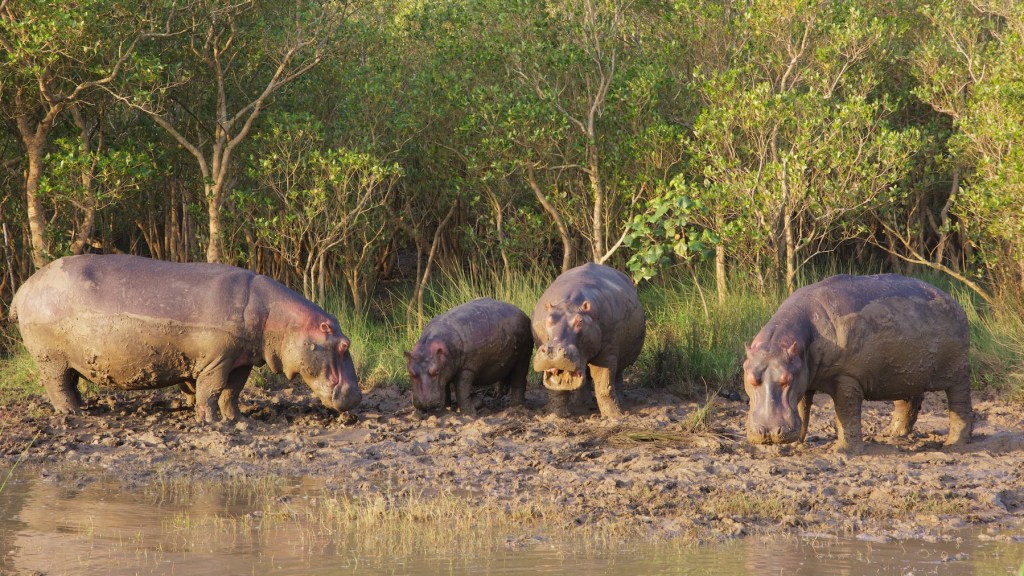We stayed four nights at the Ingweyna Lodge in St Lucia. The small town of St. Lucia lies on the KwaZulu Natal coast. It is situated at the southern entrance to the beautiful iSimangaliso Wetland Park. We only saw a small portion of the park as it stretches 280 km north and south along the coast, but what we saw was gorgeous. There was all kinds of terrain – jungle, beaches, wetlands, grassland, huge sand dunes (we didn’t get to see these) and more.


When we got out of our car at the Ingweyna Lodge we were greeted by several Vervet monkeys. I’d also read that hippos sometimes walk through the town, occasionally drinking out of the pool at our lodge! Our proprietor confirmed that by showing us the hippo path in her backyard that lead up the bank from the wetlands below. “So if you go out at night, just take a look around first and make sure there are no hippos.” You can bet I shone a flashlight every time we came back at night! I was half hoping to see a hippo but luckily we never did. We weren’t lucky enough to have one visit the pool in the middle of the night either, safe inside our room, that would have been awesome!


The Ingweyna Lodge was very nice by the way. With palm trees and monkeys and humid air, you realized you actually were in a jungle.



Our proprietor, Madeleine, was very nice and gave us a quick run-down on what to do and see in the area. Thanks to her we found out about the best hippo tour in town – Shakabarker Tours.

Each tour of the Shakabarker is led by a biologist. We were picked up at our lodge by the director of Shakabarker, Kian Barker, in a large jeep/truck that could ride over anything. Then he drove us and the other passengers down to the launching area. Our group of about 16 rode in a small river boat, like you’d ride in Disneyland’s Jungle Cruise, only much better.

Kian gave us an introductory lecture about the iSimangaliso Wetlands (prepare for a long sentence) – how the Brits tried to raise cattle there but they got sick and died from the yearly droughts and from disease; then the apartheid government planted trees to harvest lumber but they were sucking up and destroying the wetlands; and then – thank God – Nelson Mandela came into power and said, Eco-tourism and removed the trees and let the wetlands recover; then how the people all signed a petition to stop the huge sand dunes from being mined for titanium and other precious metals because they knew the metals conduct heat and help everything grow which feeds the hippos, and the hippos started coming back from the lakes and their poop makes the water permanently cloudy which causes algae to grow which feeds mollusks and fish and the crocodiles; and how the greater wetland park has expanded with international cooperation of neighboring African countries to recreate the migration routes of indigenous animals and have in sum – restored a natural paradise.


Anyway, then we went on our boat tour and saw some crocodiles (they can move fast when they want to!) and loads of hippos, right up close! Kian pulled into the weeds, probably closer then he was supposed to, saying, “In South Africa it’s better to ask for forgiveness than permission.” Then he let us click away to our hearts content.



He told us that even though crocodiles have a much more powerful bite, they can’t get their jaw around the fat hippo, whereas a hippo can chomp a crocodile in half. Also, if it comes to an underwater fight, the hippo can hold his breath longer than the crocodile and outlast him that way.

Kian also told us that a crocodile can eat a wildebeest and then not need to eat anything other than a few fish the rest of the year. The record length of a crocodile is around 21 feet.

There was golden lighting and a lovely sunset plus hot chocolate to end our trip – outstanding!




The next day we went to the beach and had an encounter with hundreds of fruit bats – but that’s another blog.
Discover more from The Footloose Scribbler
Subscribe to get the latest posts sent to your email.



